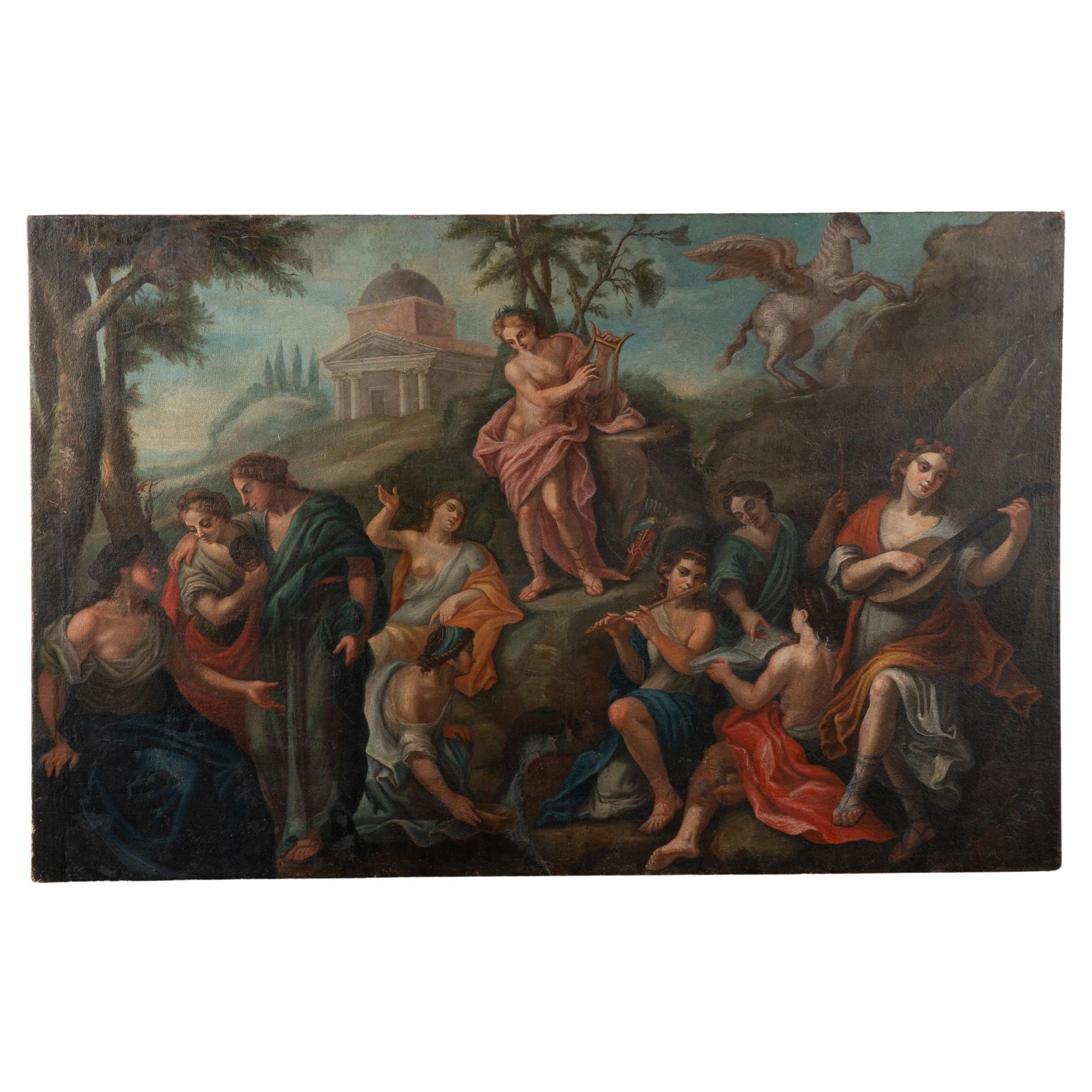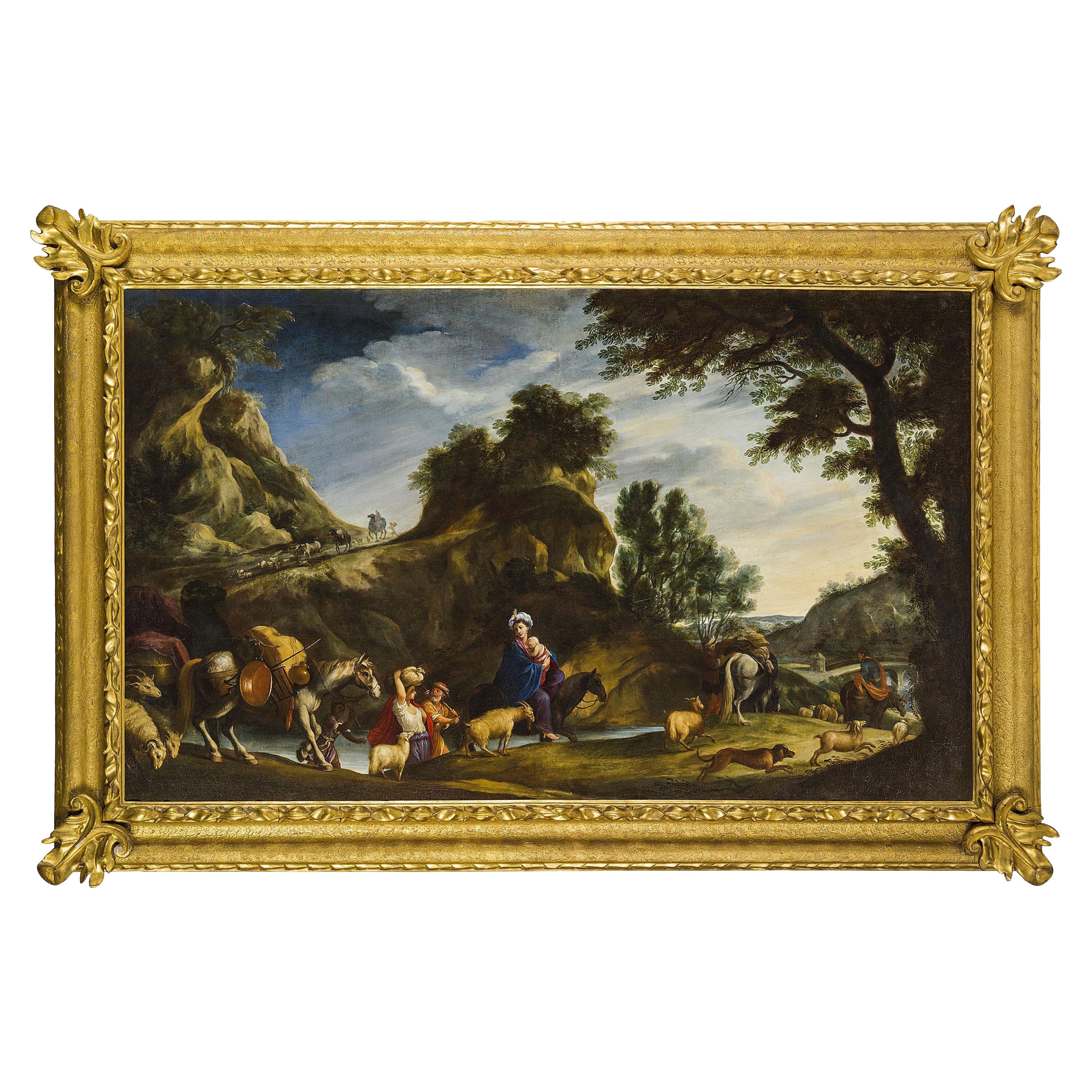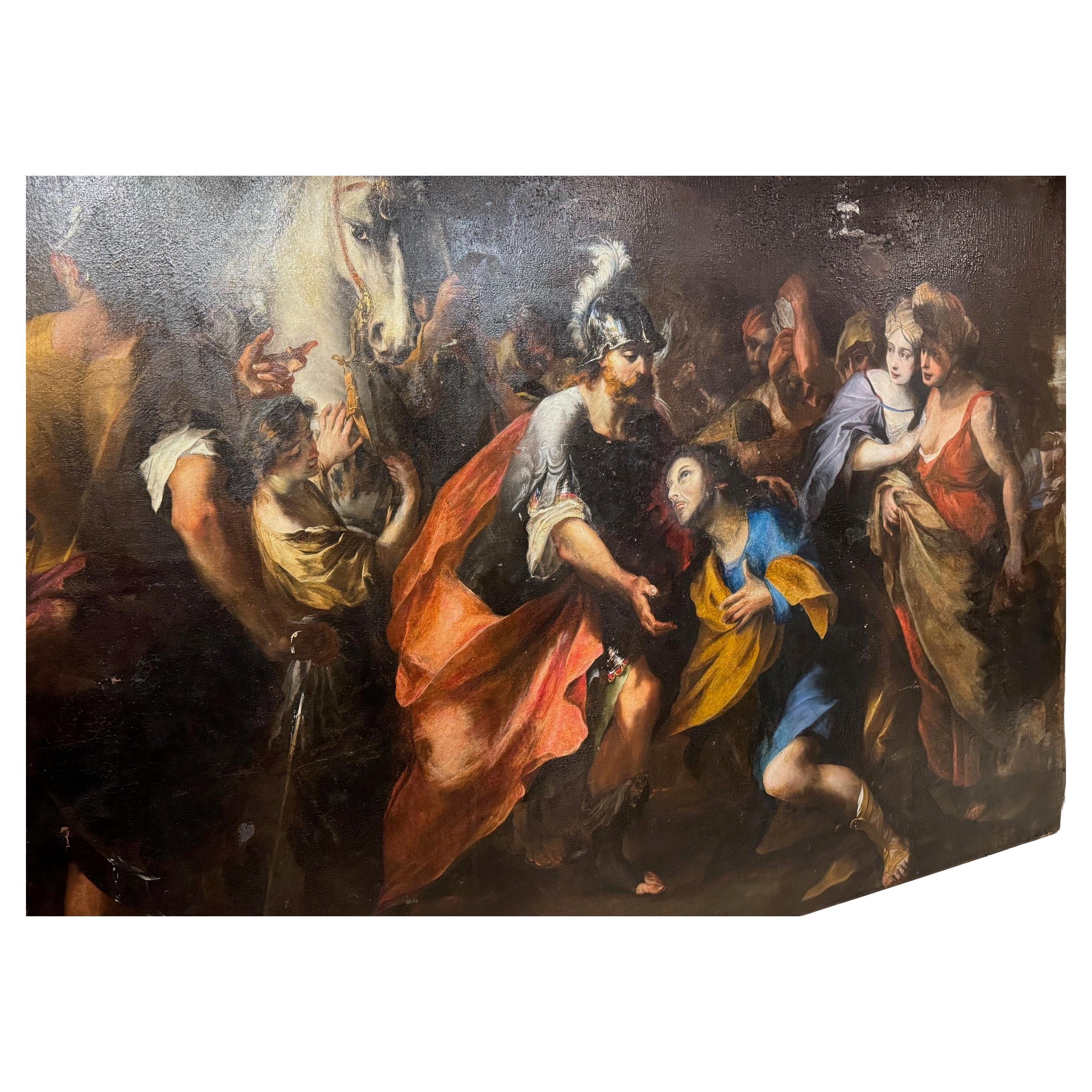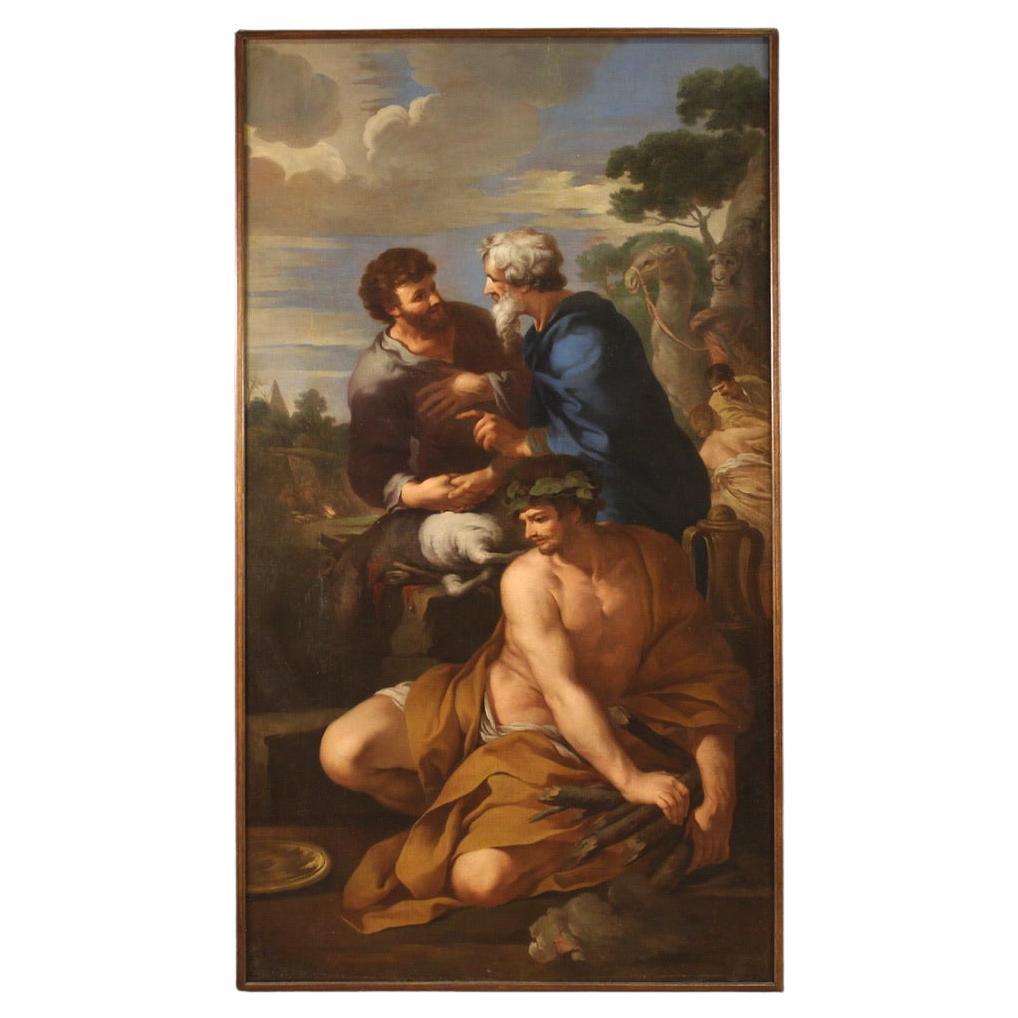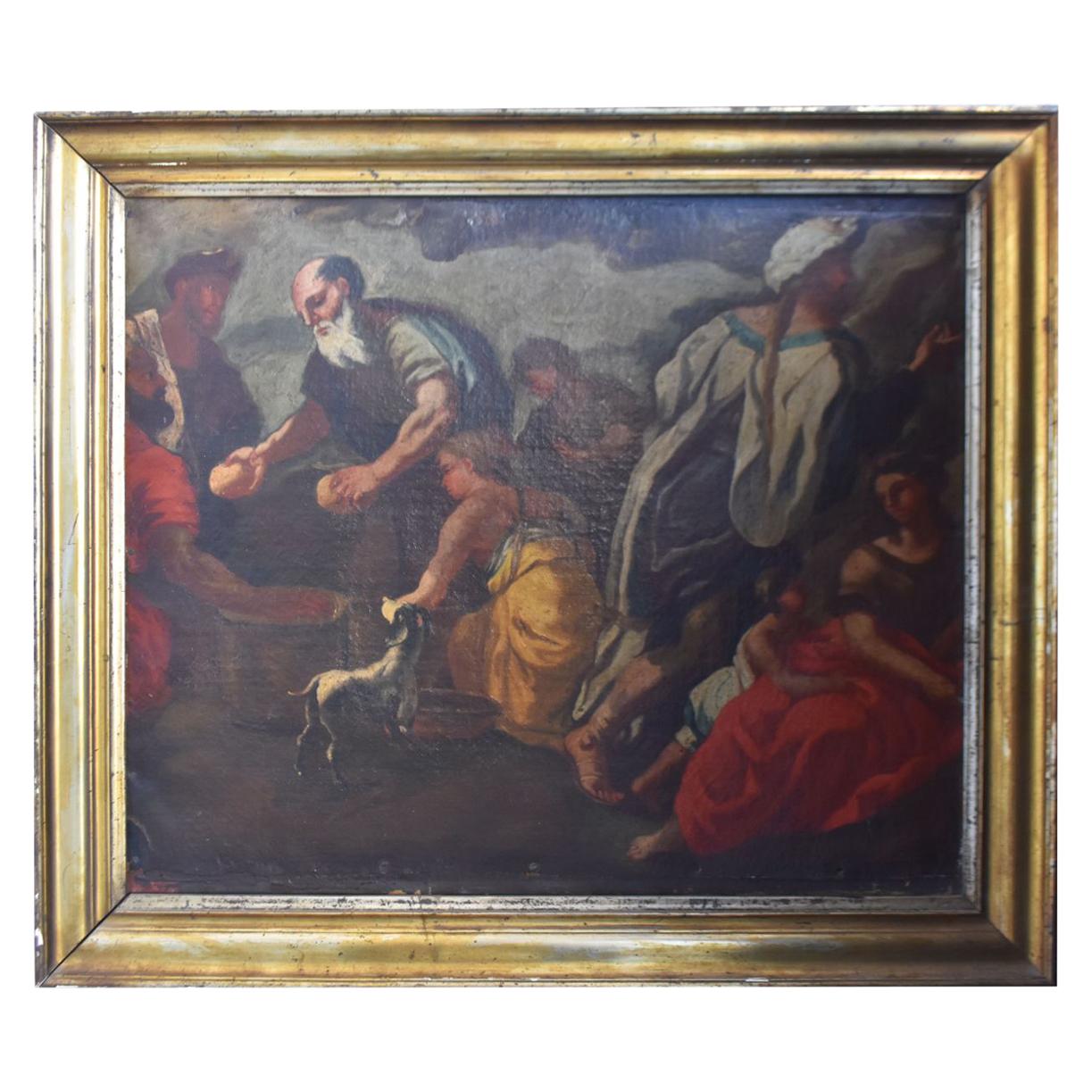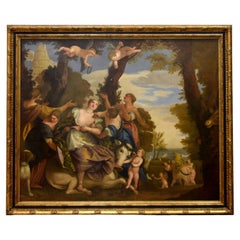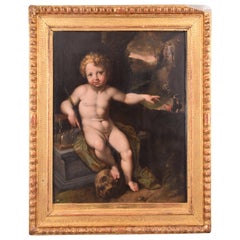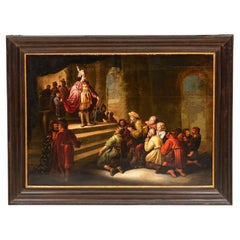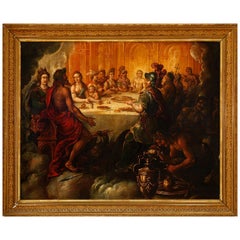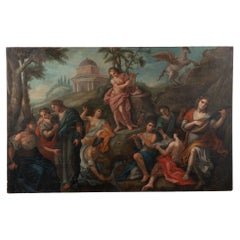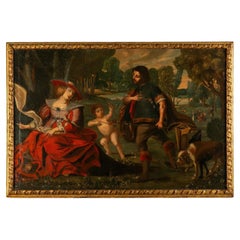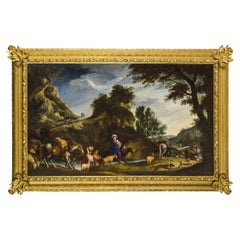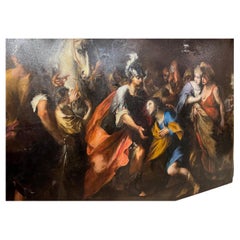Items Similar to Gathering of Manna, Oil on Canvas, 17th Century
Want more images or videos?
Request additional images or videos from the seller
1 of 11
Gathering of Manna, Oil on Canvas, 17th Century
$25,634.23
£19,332.90
€22,000
CA$35,441.55
A$39,700.50
CHF 20,852.14
MX$482,745.34
NOK 264,056.15
SEK 250,660.29
DKK 167,478.40
About the Item
Jews in the desert collecting the Manna. Oil on canvas, XVII century.
Oil on canvas arranged horizontally in which a figurative theme is shown with a mountainous landscape in the background. In the foreground, a series of figures have been placed creating various planes and highlighting with their postures and gestures the two figures in the center; a little further to the bottom, to the right, there are some tents and a series of "cut out" figures. Note the presence of vases and other containers, decorated and with forms of clear classicist influence.
The iconographic series of Moses (Exodus) has a large number of themes, and one of them is that of the fall and collection of Manna in the desert, which should take place before the sun melted this food that God gave to the Jews six days a week.
Stylistically, note the anatomical study of the figures with their backs in the foreground, with which a space is created prior to the "protagonist" Moses, situated raising his hand and looking up at the sky, and the variety of positions and the care of the composition, which results in a very clear work despite the number of figures present in it.
· Size: 208 x 6 x 154 cms. Weight is merely orientative.
- Dimensions:Height: 60.63 in (154 cm)Width: 81.89 in (208 cm)Depth: 2.37 in (6 cm)
- Style:Baroque (Of the Period)
- Materials and Techniques:
- Place of Origin:
- Period:
- Date of Manufacture:17th Century
- Condition:Wear consistent with age and use. Minor losses. Minor structural damages. Minor fading.
- Seller Location:Madrid, ES
- Reference Number:Seller: ZE2831stDibs: LU2951323387922
About the Seller
4.9
Vetted Professional Seller
Every seller passes strict standards for authenticity and reliability
Established in 1985
1stDibs seller since 2017
347 sales on 1stDibs
Typical response time: 8 hours
- ShippingRetrieving quote...Shipping from: MADRID, Spain
- Return Policy
Authenticity Guarantee
In the unlikely event there’s an issue with an item’s authenticity, contact us within 1 year for a full refund. DetailsMoney-Back Guarantee
If your item is not as described, is damaged in transit, or does not arrive, contact us within 7 days for a full refund. Details24-Hour Cancellation
You have a 24-hour grace period in which to reconsider your purchase, with no questions asked.Vetted Professional Sellers
Our world-class sellers must adhere to strict standards for service and quality, maintaining the integrity of our listings.Price-Match Guarantee
If you find that a seller listed the same item for a lower price elsewhere, we’ll match it.Trusted Global Delivery
Our best-in-class carrier network provides specialized shipping options worldwide, including custom delivery.More From This Seller
View AllAbduction of Europe Oil on Canvas, 18th Century, After Veronese
By Paolo Veronese
Located in Madrid, ES
Rapture of Europe Oil on canvas. 17th century, following the model of VERONESE, Paolo Caliari (Verona, 1528-Venice, 1588).
Oil on canvas showing a scen...
Category
Antique 18th Century European Baroque Paintings
Materials
Other
Allegory of Time. Oil on panel. Circle of Jacob de Backer (act. 1571-1585).
Located in Madrid, ES
Allegory of Time. Oil on panel. Circle of Jacob de Backer (act. Antwerp, 1571-1585).
Exhibition: “Reality, time and artifice. Still life and vanitas in baro...
Category
Antique 16th Century Belgian Renaissance Paintings
Materials
Other
Joseph and his brothers. Oil on canvas. Dutch school, based on models by Andria
Located in Madrid, ES
Joseph and his brothers. Oil on canvas. Dutch school, based on models by Andriaen Verdoel (Flesingen, circa 1620-1675).
Some damages.
Oil on canvas depicting a figurative scene in ...
Category
Antique 17th Century European Other Paintings
Materials
Other
"Wedding of Tethys and Peleus", Oil on Canvas, School of Madrid, Spain
Located in Madrid, ES
"Wedding of Tethys and Peleus". Oil on canvas. School of Madrid, 17th century. Corte, Juan de la (Antwerp, circa 1585 - Madrid, 1662) circle.
This work describes the weddings of the Nereid Thetis and the prince Peleo, parents of Achilles. It was celebrated on Mount Pelion, and all the deities came, although Eris, the goddess of discord, was not invited. In revenge, she threw a golden apple in which she said "for the most beautiful", that caused the dispute between Athena, Aphrodite and Hera that led to the Trial of Paris, to finally bring about the Trojan War. The banquet is depicted with a composition worked in depth, located in a rich interior of classical architecture illuminated by the light of Apollo, which is situated at the far end of the viewer. At the head of the table, in the foreground, appears Zeus, accompanied by the eagle and Hera, queen of the gods, to his left. In the lower right corner we see a group of satyrs serving the wine, accompanied by rich metal vessels worked with a detailed and descriptive brushstroke. The rest of the gods appear clearly differentiated, with Athena in the foreground to the right and, following an agile rhythm in zigzag, typically baroque, Aphrodite with Eros, Hermes and the grooms, to the left, and to the right Poseidon. Formally it is a work perfectly framed within the 17th century school of Madrid, developed around the court.
Thus, we see a sumptuous, allegorical classicist baroque, where the studies of light and color are especially relevant, revealing the exalted and luminous tone typical of this school's maturity. In particular, we can relate this painting to the circle of Juan de la Corte, painter of Flemish origin. We know nothing of his first formation today, for Palomino's assertion of his birth in Spain was documented, quoting in his testament that he was born in Antwerp. Also conserved documents in which the painter declares his apprenticeship in Flanders, where "it exerted his office by many years". For all this he has been associated with Flemish artists of the time who, due to personal knowledge or the study of his works, strongly influenced the configuration of his personal language. We know of his establishment in Spain at least since 1613. His work at the court encouraged him to ask for the place of royal painter who left vacant Bartolomé González...
Category
Antique 17th Century Spanish Baroque Paintings
Materials
Canvas
Landscape with Classical Ruins, Oil on Canvas, Attributed to Giner, Vicente
Located in Madrid, ES
Landscape with classical ruins. Oil on canvas. Attributed to Giner, Vicente (ca. 1636-1681).
Reengineered (reentelado in spanish).
Landscape with rocks and buildings in the background that presents, in the foreground, constructions with a marked classicist air, accompanied by two female sculptures on two pedestals. At the foot of this building, there is a group of people, dressed in the classic way (women, children and a soldier with a spear). Vicente Giner, canon and artist from Castellón, is documented working in Rome during the last quarter of the seventeenth century (until he died here in 1681), where he requested, together with others, from Carlos II...
Category
Antique 17th Century European Baroque Paintings
Materials
Other
The temptation of St Anthony. Oil on canvas. 17th c., after David Teniers II
By David Teniers the Younger
Located in Madrid, ES
Temptations of San Antonio Abad. Oil on canvas. 17th century, following the model of David Teniers II (Antwerp, 1610-Brussels, 1690).
Oil on canvas showing a figurative scene located inside a cave. To the right, you can see a cross standing, supported; to the left, a hut; and in the center of the painting appears an elderly, bearded man, leaning on a table on which there is a ceramic jug and a skull, with an open book at the foot of it. The man looks towards a woman, who points to something outside, and appears accompanied by a large frog and a series of ghostly beings or monsters dressed in brightly colored cloth and clothing.
San Antonio Abad or Antonio Magno (251-356) was a Christian monk, considered the founder of the eremitical movement. He was tempted numerous times by the devil while he was in the desert, becoming a subject frequently represented in art (as can be seen in this oil painting). He is represented in a black habit because the Order of the Knights of the Hospital of San Antonio (Hospitals) was placed under his patronage, being the color of the habits of the members of this order (the tau or Egyptian cross was also the symbol chosen by they).
David Teniers II or El Joven was a prominent Flemish painter and engraver, son of David Teniers El Viejo or I and father of David Teniers III, much appreciated at the time for his scenes of villagers and common people, his paintings of monkey painters, etc. . He dealt with the theme of the Temptations of Saint Anthony...
Category
Antique 17th Century European Baroque Paintings
Materials
Other
You May Also Like
Original Oil On Canvas Large Allegorical Painting, Italian School 1750-1800
Located in Round Top, TX
Original large oil on canvas allegorical scene from Italy with vivid colors. Note the Pegasus, ten figures, and use of lute, lyre and flute.
Condition: Age related craquelure throug...
Category
Antique 18th Century Italian Paintings
Materials
Canvas, Wood, Paint
Late 17th Century Painting Follower of Johann Hulsman "Gallant Scene"
Located in Montreal, QC
oil on canvas German 17th school follower of Johann Hulsman "Gallant Scene"
written "Bonhams" in chalk on the stretcher
Condition: Presents well, vibrant colours relined probably in...
Category
Antique 1680s German Baroque Paintings
Materials
Canvas
17th Century, Italian Painting by Pier Francesco Cittadini, Jacob and his Family
Located in IT
Pier Francesco Cittadini (Milan, 1616-Bologna, 1681)
"Jacob and his family go to Egypt"
Oil on canvas, cm 109 x 190 (canvas only)
The valuable painting, made in oil on canvas, depicts Jacob and his family go to Egypt and we believe it can be, given the high quality painting, autograph work of Italian Pier Francesco Cittadini (Italy Milan, 1616 - Bologna, 1681) made after 1647. The work, in excellent condition is accompanied by a coeval frame in wood finely carved and golden.
The scene depicted, which was confused with the Flight to Egypt in the past years, is instead identified with the biblical episode of Jacob’s journey. In the foreground, reading the painting from left to right, we see a caravan composed of animals, including donkeys, dromedaries, goats, dogs and horses and people, women, men and slaves, who carry on their journey along the banks of a river, following a path that to the right, would seem to lead to the through of a bridge. In addition to the watercourse is described an environment characterized by large rocks and impervious come far to cover the entire verticality of the canvas. On the left, in the distance, we see the tail of the caravan that runs along the steep path. Large trees enliven and harmonize the environment, as well as white and grey clouds characterize the predominantly clear sky and illuminated on the right by sunlight.
The story is told in the Bible, Book of Genesis, 30, 25, passage in which is described the flight of Jacob from Haran after the contrasts with Laban, father of his wife Rachel. Jacob is the third great patriarch of the Bible. From his descendants originate the twelve generations of the people of Israel. He is the son of Isaac and Rebekah, who led him to flee from the wrath of Esau to Haran to seek refuge from his brother, Laban. At his uncle’s house Jacob met his daughter Rachel. As soon as he saw his cousin, Jacob was taken. Jacob will stay seven years in the service of Laban to marry his beloved Rachel. But Laban, with a deception, will give him in marriage first Lia, the least beautiful eldest daughter, and only after another seven years the splendid Rachel. From his first wife he will have several children, while Rachel will give birth to the beloved son, Joseph, who will become viceroy of Egypt.
After years of service, Jacob asked to be paid with every dark-coloured garment among the sheep and every spotted and dotted garment among the goats. Laban accepted and sent away from his sons all the leaders of that kind. So Jacob took fresh branches of poplar, almond and plane tree, and flayed them, and put them in the troughs. The optical suggestion induced the goats and the sheep to conceive and give birth to dark, striped and dotted garments. He also ensured that all the strongest and healthiest leaders of the flock of Laban would drink near the barked branches, thus assuring a genetic superiority to his part of the flock. His flocks grew numerous and strong and he became richer than his relative, arousing envy. It was clear that Laban would not respect him much longer. At the suggestion of the Lord, Jacob decided to return to Canaan. Trying to avoid any possible dispute, he left with his family while Laban was absent for shearing sheep. But when, three days later, his uncle returned home, he became angry, feeling offended because Jacob had gone secretly and had not allowed him to greet his daughters and grandchildren. In addition, his teraphim, statuettes, or idols, which depicted the family deities, had disappeared. After 7 days of pursuit, Laban and his men reached Jacob’s group on Mount Gilead, in the mountainous region west of the Euphrates River, where his uncle and grandson had a stormy conversation. The younger man was outraged at being accused of stealing idols and told Labano to rummage through his family’s tents at will. Neither of them could know or even imagine that it was Rachel who took the idols and hid them in the saddle of the camel. During the search, she sat down firmly on the saddle, apologizing for not being able to get up, «because I usually have what happens to women» (Gen 31:35). So the loot wasn’t discovered.
The author of this work was inspired by the composition of an engraving by Stefano Della Bella (1610-1664) of circa 1647. The engraving by Stefano della Bella bears the title "Iacob sur ses vieux jours quitte sans fascherie pour voir son filz Ioseph, sa terre et sa patrie" and is signed on the bottom left "Stef. of the Beautiful In. et fe." while on the right it is declared "Cum privil. Regis", that is with license of the king.
Stefano Della Bella (Italy - Florence, May 18, 1610-Florence, July 12, 1664) was born in a family of painters, sculptors and goldsmiths and was left early orphan of his father sculptor, he dedicated himself first to the art of goldsmith at the school of Giovanni Benedetto Castiglione and Gasparo Mola, then turning his attention to drawing and engraving. He soon began drawing figures and copying the etchings of Jacques Callot, which inspired his early works. Under the protection of the Medici, in particular of Don Lorenzo, cadet son of Grand Duke Ferdinand I, Della Bella has the opportunity to make study trips to Rome, where he stayed from 1633-1636; In Rome he met French engravers and publishers of prints such as Israël Henriet and François Langlois, who influenced his decision to move to Paris in 1639, four years after the death of Callot. In Paris he soon reached, thanks to the engravings commissioned by Cardinal Richelieu, the success also worldly; he frequented courtiers, theatre artists and writers, while refusing too oppressive honors. In 1646-1647 he continued his travels in the Netherlands to Amsterdam, Antwerp and Dordrecht. He returned to Florence in 1650 and resumed working under the protection of the Medici court, working for his patrons. In 1656 he became a member of the Academy of Apatists.
The painting object of this study is reasonably attributable to Pier Francesco Cittadini, or Pierfrancesco Cittadini, called the Milanese or the Franceschino (Italy - Milan, 1616-Bologna, 1681) as some exemplary stylistic comparisons proposed to follow can prove.
Pier Francesco Cittadini was an Italian baroque painter, mainly active in Bologna.
His artistic training first took place with the painter Daniele Crespi...
Category
Antique Mid-17th Century European Baroque Paintings
Materials
Canvas, Giltwood
A Huge Painting , Biblical Scene , Late 17th Century Florentine School.
Located in PARIS, FR
A Huge Painting , Biblical Scene , Late 17th Century Florentine School representing the reconciliation of Esau and Jacob.
Seeking reconciliation with his brother Esau, Jacob, after ...
Category
Antique Late 17th Century Paintings
Materials
Canvas
17th Century Oil on Canvas Italian Antique Religious Painting, 1650
Located in Vicoforte, Piedmont
Splendid 17th century Italian painting. Oil painting on canvas depicting the alliance of Jacob and Laban. The subject is inspired by a canvas by Pietro da Cortona (1596-1669), preser...
Category
Antique 1650s Italian Paintings
Materials
Canvas
$11,185 Sale Price
20% Off
Free Shipping
17th Century Italian School Biblical Scene
Located in Marseille, FR
17th century oil on canvas representation of the "Feeding of the 4,000" of Italian school.
Category
Antique 17th Century French Baroque Paintings
Materials
Canvas
More Ways To Browse
Hitler Bust
Leonard Maurer
Newman Decor
P Fortunato
Painting Ship Whale
Percy French
Pichhavai Painting
Pileated Woodpeckers
Porcelain Paintings Mary Magdalene
Rabbit Wicker
Rapids Boston
Ray Frost Fleming
Shaw Of London Furniture History
Thomas Aquinas
Used Furniture Markham
Vadim Garine
Vintage Furniture Colchester
Wall Pappers
